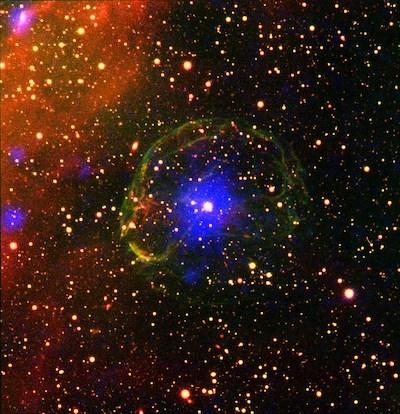Pulsars Help Monitor Satellite Navigation Timing
ESA’s technical center in the Netherlands has begun running a pulsar-based clock. The ‘PulChron’ system measures the passing of time using millisecond-frequency radio pulses from multiple fast-spinning neutron stars.

Operating since the end of November, this pulsar-based timing system is hosted in the Galileo Timing and Geodetic Validation Facility of ESA’s ESTEC establishment, at Noordwijk in the Netherlands, and relies on ongoing observations by a five-strong array of radio telescopes across Europe.
Neutron stars are the densest form of observable matter in the cosmos, formed out of the collapsed core of exploding stars. Tiny in cosmic terms, on the order of a dozen kilometers in diameter, they still have a higher mass than Earth’s Sun.
A pulsar is a type of rapidly rotating neutron star with a magnetic field that emits a beam of radiation from its pole. Because of their spin – kept steady by their extreme density – pulsars as seen from Earth appear to emit highly regular radio bursts – so much so that in 1967 their discoverer, UK astronomer Jocelyn Bell Burnell, initially considered they might be evidence of ‘little green men’.
“PulChron aims to demonstrate the effectiveness of a pulsar-based timescale for the generation and monitoring of satellite navigation timing in general, and Galileo System Time in particular,” explains navigation engineer Stefano Binda, overseeing the PulChron project. “A timescale based on pulsar measurements is typically less stable than one using atomic or optical clocks in the short term but it could be competitive in the very long term, over several decades or more, beyond the working life of any individual atomic clock.
“In addition, this pulsar time scale works quite independently of whatever atomic clock technology is employed – it doesn’t rely on switches between atomic energy states but the rotation of neutron stars.”
PulChron sources batches of pulsar measurements from the five 100-m class radio telescopes comprising the European Pulsar Timing Array – the Westerbork Synthesis Radio Telescope in the Netherlands, Germany’s Effelsberg Radio Telescope, the Lovell Telescope in the UK, France’s Nancay Radio Telescope and the Sardinia Radio Telescope in Italy. This multinational effort monitors 18 highly precise pulsars in the European sky to search out any timing anomalies, potential evidence of gravitational waves – fluctuations in the fabric of spacetime caused by powerful cosmic events.
For PulChron, these radio telescope measurements are used to steer the output of an active hydrogen maser atomic clock with equipment based in the Galileo Timing and Geodetic Validation Facility – combining its extreme short- and medium-term stability with the longer-term reliability of the pulsars. A ‘paper clock’ record is also generated out of the measurements, for subsequent post-processing checks.
ESA established the Timing and Geodetic Validation Facility in the early days of the Galileo programme, first to prepare for ESA’s two GIOVE test satellites and then in support of the world-spanning Galileo system, based on ‘Galileo System Time’ which needs to remain accurate to a few billionths of a second. The Facility continues to serve as an independent yardstick of Galileo performance, linked to monitoring stations across the globe, as well as a tool for anomaly investigation.
"The TGVF provided a perfect opportunity to host the PulChron because it is capable of integrating such new elements with little effort, and has a long tradition in time applications, having been used even to synchronise time and frequency offset of the Galileo satellites themselves," Binda said.
PulChron’s accuracy is being monitored down to a few billionths of a second using ESA’s adjacent UTC Laboratory, which harnesses three such atomic hydrogen maser clocks plus a trio of caesium clocks to produce a highly-stable timing signal, contributing to the setting of Coordinated Universal Time, UTC – the world’s time. The gradual diversion of pulsar time from ESTEC’s UTC time can therefore be tracked – anticipated at a rate of around 200 trillionths of a second daily.
This project is supported through ESA’s Navigation Innovation and Support Program (NAVISP), applying ESA’s hard-won expertise from Galileo and Europe’s EGNOS satellite augmentation system to new satellite navigation and – more widely – positioning, navigation and timing challenges.
PulChron is being led for ESA by GMV in the UK in collaboration with the University of Manchester and the UK’s NPL National Physical Laboratory.
(Image provided with ESA news release)
 ANN's Daily Aero-Term (04.24.24): Runway Lead-in Light System
ANN's Daily Aero-Term (04.24.24): Runway Lead-in Light System ANN's Daily Aero-Linx (04.24.24)
ANN's Daily Aero-Linx (04.24.24) Aero-FAQ: Dave Juwel's Aviation Marketing Stories -- ITBOA BNITBOB
Aero-FAQ: Dave Juwel's Aviation Marketing Stories -- ITBOA BNITBOB Classic Aero-TV: Best Seat in The House -- 'Inside' The AeroShell Aerobatic Team
Classic Aero-TV: Best Seat in The House -- 'Inside' The AeroShell Aerobatic Team Airborne Affordable Flyers 04.18.24: CarbonCub UL, Fisher, Affordable Flyer Expo
Airborne Affordable Flyers 04.18.24: CarbonCub UL, Fisher, Affordable Flyer Expo



